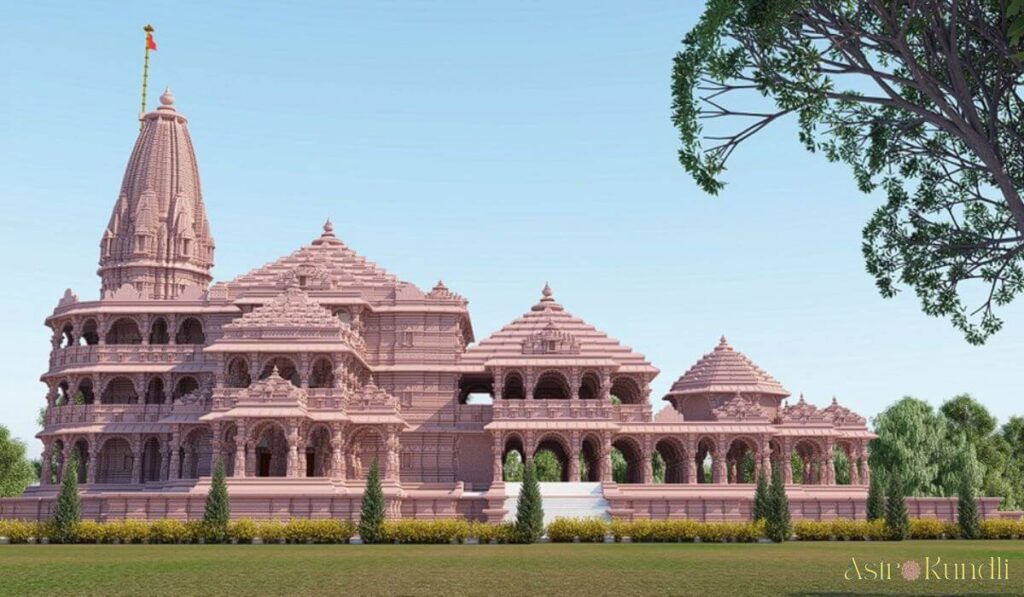Table of Contents
The Ram Mandir is also known as the Ram Janmabhoomi Mandir. It’s a Hindu temple that was under construction and is now completely built in Ayodhya – Uttar Pradesh, India. This temple is considered very important as it has great religious and historical significance.
Religious Importance: The temple is dedicated to Lord Ram (a highly respected deity in Hinduism and the main character in the epic Ramayana). The place where the temple has been constructed is considered to be the birthplace of Lord Ram. Making it a very sacred location in Hinduism.
Historical Importance: Earlier there was a mosque called Babri Masjid on the same location but it was demolished in 1992. The Supreme Court in 2019 ruled in favour of the Hindu parties and approved the construction of the temple. Hence it’s important to note that the construction of the temple involves a long and complicated legal and social battle about the ownership of the land.

When will Ram Mandir open to visitors?
The newly constructed monument was opened to public visitation on Tuesday January 23, 2024. The ceremony of worshipping the Ram Lalla idol was done on January 22 in the presence of Prime Minister Narendra Modi and other VIP guests that were invited to offer prayers to Ram Lalla.
Ram Mandir: Construction, Design, Idols and Size
The construction of the temple began in March 2020 following the Supreme court’s verdict. It is designed in the Nagara style including:
- Towering shikharas (spires) rising 161 feet high
- Five domes as symbols of the 5 elements of creation
- Detailed carvings and sculptures showing scenes from the Ramayana and Hindu mythology
- It has been designed as per vastu shastra principles
Lord Ram’s idol stands 4.25 feet tall in the sanctum sanctorum or garbha griha (innermost shrine).

The temple walls and pillars have been decorated with thousands of smaller idols of various deities and figures from Hindu mythology.
The original design of the temple was imagined by the Sompura family. The family has renowned temple architects for over 15 generations. The chief architect was Chandrakant Sompura who was helped by his sons Nikhil and Ashish Sompura. The design was recreated in 2020 to be more linked to the Hindu scriptures.
Coming to the idols now. The idols have 2 different creators. Lord Ram’s idol was sculpted by Arun Yogiraj. He is a famous sculptor from Karnataka. He is also known for creating the Netaji statue at India Gate and the Adi Shankaracharya statue in Uttrakhand.
Additionally the idols of Lakshman and Sita were created by Satyanarayan Pandey. He is also a famous sculptor from Ayodhya. The idols were created from white marble and decorated with gold.
The location of the temple covers an area of 2.7 acres (1,17,612 square feet). The temple itself is 76 meters (250 feet) wide, 120 meters (380 feet) long and 49 meters (161 feet) high. There are 392 columns and 44 doors in the temple.
The Significance of Ram Mandir
Ram Mandir holds immense religious and historical importance because it’s associated with Lord Ram who is a revered god in Hinduism. The temple itself is connected to the pride of Hindus and their culture.
The temple will also boost Ayodhya and nearby areas from an economic point of view as well since it will attract a lot of religious people and also tourists.
Ram is considered to be the best example of Hindu ideals such as being loyal, brave and honesty. People look up to him as the perfect son, brother, husband and king. It’s believed that Ram is an incarnation of Lord Vishnu who is one of the most important Hindu gods. This is also one of the reasons that make Ram important and gives the Ram Mandir holistic importance.
But Why Ayodhya?
The temple has been constructed in Ayodhya because it’s considered to be the place where Ram was born. This information comes from old Hindu scriptures stories like the Ramayana. Visiting Ayodhya and praying at its temples is important spiritually for millions of followers.
What is the Nagara-style architecture?
It is a famous style of building temples most commonly found in northern, western and eastern India. It’s also referred to as the North Indian temple style.
Place and time of Origin
The Nagara-style architecture originated around the 5th century CE in North India along the same time as the Dravidian style in the South. Found in regions like Madhya Pradesh, Uttar Pradesh, Rajasthan, Gujarat, Odisha, Jharkhand, Bihar, Maharashtra, Andhra Pradesh (near Odisha) and West Bengal (southwest and Sundarbans areas).
Key characteristics
- Elevated platform: Temples are usually made on a stone platform that is raised off of the ground and includes steps that lead up to the main building.
- Shikhara (spire): The most recognizable feature is one or more tall spires that turn inward at the top. These spires come in different shapes and styles each with unique decoration.
- Garbagriha (inner sanctum): The main deity is placed in the Garbhagriha which is right below the largest shikhara.
- Mandapa (hall): There are more pillared rooms that are used for ceremonies and gatherings.
- Intricate carvings: The outside of buildings is often decorated with sculptures and carvings that show gods, mythological scenes and geometric designs.
- Lack of boundary walls: Nagara styles usually don’t include fancy walls around the building like Dravidian temples.
Frequently Asked Questions (FAQs)
Q1: What is special about Ram Mandir?
Ram Mandir holds immense religious and historical importance because it’s associated with Lord Ram who is a revered god in Hinduism. The temple itself is connected to the pride of Hindus and their culture.
Q2: Who founded Ram Mandir?
The concept of founder of Ram Mandir is not as clear as it is for other institutions. There were some important roles and people played in its creation:
- Swami Ramchandra Paramhans was in charge of the Ram Janmabhoomi Nyas Trust. He fought for the construction of the temple by means of court cases and public protests.
- Prime Minister Narendra Modi’s government agreed with the decision by Supreme Court and supported the building by setting up a trust.
- The main builder is Chandrakant Sompura who planned the design of the temple according to Vastu Shastra.
Q3: Why is Ayodhya sacred?
Ayodhya is considered to be sacred because it’s believed to be the place where Ram was born. This information comes from old Hindu scriptures stories like the Ramayana.
Q4: Which stone is used in Ram statue?
The statue of Lord Ram is not actually made of stone. It was carved from a type of black granite. The black granite is also called Krishna Shila.





Pingback: Ayodhya Ram Mandir: An Architectural Marvel - Astro Kundli